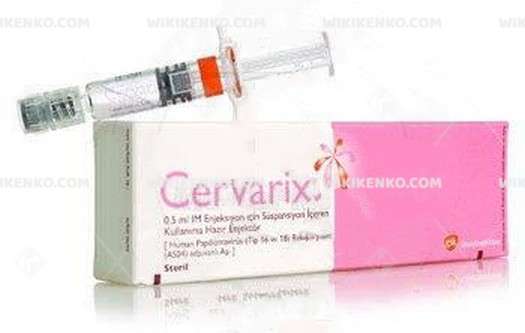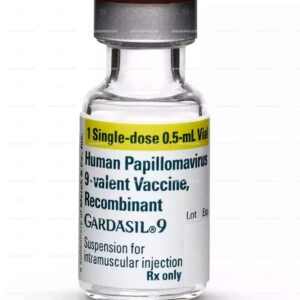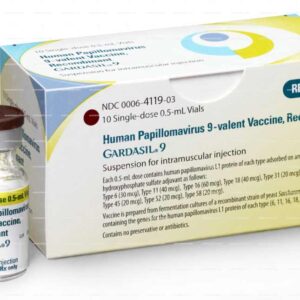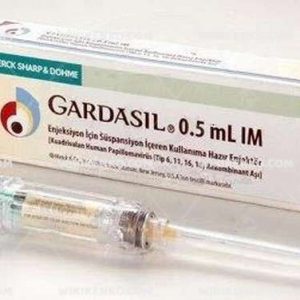Cervarix Vaccine
In the relentless battle against Human Papillomavirus (HPV), Cervarix emerges as a potent vaccine, offering protection against specific diseases caused by this common virus. This comprehensive guide sheds light on Cervarix’s dosage, administration, effectiveness, and safety, providing crucial insights to make informed decisions about safeguarding health.
| Dosage form | |
|---|---|
| Pack size | |
| Potency | 0.5Ml (Tek Doz) 1X0.5Ml |
| Manufacturer | |
| Origin | |
| Generic Name (Ingredient) | Combined |
Assuming your emergency circumstances for this product, visit Urgent Quotation page. Besides, for any pharmaceutical questions, please ask us in the comments section.
Description
Cervarix is administered intramuscularly as a suspension for injection, available in vials or prefilled syringes. It is typically given according to either a two-dose or a three-dose schedule, with slight variations depending on the recipient’s age group.
Dosage and Method
For males and females aged 9 to 14 years, the two-dose schedule is recommended, with the second dose administered between five and thirteen months after the initial dose. On the other hand, for those aged 15 years and above, as well as females aged 9 to 14 years opting for the three-dose schedule, the second dose should be administered two months after the first, and the third dose given four months after the second.
It is essential to maintain a minimum of one month between the first and second doses, and at least three months between the second and third doses. All doses should be administered within a year for optimal protection. Individuals who receive the first dose of Cervarix are strongly encouraged to complete the full dosing regimen.
Method of Administration
To maximize safety and efficacy, Cervarix should be administered intramuscularly in the deltoid region of the upper arm or the higher anterolateral area of the thigh.
Indications and Usage
Cervarix is a valuable preventive measure for both males and females from the age of 9 years and older, offering protection against cervical and anal cancers, as well as precancerous lesions in the genital area (cervix, vulva, vagina, or anus) caused by specific types of HPV.
Limitations of Use
While Cervarix is a powerful tool in the fight against HPV-related diseases, it is crucial to note that vaccination does not replace the need for women to continue recommended cervical cancer screening. Regular screening remains an essential aspect of preventive healthcare.
Side Effects
As with any medication, Cervarix may cause side effects, but they are generally mild and transient. The most common side effects include mild pain, redness, itching, or swelling at the injection site. Some individuals may experience headaches, which usually subside quickly.
Less common side effects may include fever, nausea, and joint or muscle pain. In rare cases, people may develop an itchy red rash (hives), while extremely rare instances may involve difficulty breathing and airway restriction.
It’s important to remember that these side effects are typically mild and resolve on their own within a few days. However, if any side effects persist or cause concern, promptly seek advice from your healthcare provider.
Pregnancy and Breastfeeding
x is not expected to harm an unborn baby. However, it’s crucial to note that the HPV vaccine is not recommended for use during pregnancy. If a person is known to be pregnant, the initiation of the vaccination series should be delayed until after the pregnancy. It’s important to stress that pregnancy testing before vaccination is unnecessary.
Regarding breastfeeding, there is limited information available on the use of Cervarix during this period. According to some sources, Cervarix is likely safe to use during breastfeeding. Other sources indicate that maternal vaccination with the HPV vaccine is not a contraindication to breastfeeding. As always, it is recommended to consult with your healthcare provider to address any specific concerns.
Comparing Cervarix with Other HPV Vaccines
In the quest for HPV protection, there are currently three different vaccines available: Cervarix, Gardasil, and Gardasil 9. Each vaccine offers specific protection against various HPV types.
Cervarix is a bivalent vaccine, providing protection against two HPV types (16 and 18). Gardasil, a quadrivalent vaccine, protects against the same two types as Cervarix, in addition to HPV types 6 and 11, responsible for 90% of genital warts. The newest addition, Gardasil 9, is a nonavalent vaccine, safeguarding against nine HPV types (6, 11, 16, 18, 31, 33, 45, 52, and 58), which cause about 15% of cervical cancers.
All three vaccines have demonstrated high efficacy in preventing HPV infection among the targeted types. The choice of vaccine may depend on individual factors, such as age and gender. To make an informed decision, it is essential to discuss with your healthcare provider, who can tailor the choice based on your specific needs.
Conclusion
As HPV-related diseases continue to pose a significant health challenge, proactive prevention through vaccination is key. Cervarix stands as a valuable defense, offering protection against specific HPV types, ultimately reducing the risk of cervical and anal cancers, as well as precancerous lesions.
Embrace the power of prevention with Cervarix and take charge of your health journey. Consult with your healthcare provider to determine the best vaccination strategy for your individual needs. Together, we can pave the way to a healthier, HPV-free future.
Use the form below to report an error
Please answer the questions as thoroughly and accurately as possible. Your answers will help us better understand what kind of mistakes happen, why and where they happen, and in the end the purpose is to build a better archive to guide researchers and professionals around the world.
The information on this page is not intended to be a substitute for professional medical advice, diagnosis, or treatment. always seek the advice for your physician or another qualified health provider with any questions you may have regarding a medical condition. Always remember to
- Ask your own doctor for medical advice.
- Names, brands, and dosage may differ between countries.
- When not feeling well, or experiencing side effects always contact your own doctor.
Cyberchondria
The truth is that when we’re sick, or worried about getting sick, the internet won’t help.
According to Wikipedia, cyberchondria is a mental disorder consisting in the desire to independently make a diagnosis based on the symptoms of diseases described on Internet sites.
Why you can't look for symptoms on the Internet
If diagnoses could be made simply from a textbook or an article on a website, we would all be doctors and treat ourselves. Nothing can replace the experience and knowledge of specially trained people. As in any field, in medicine there are unscrupulous specialists, differences of opinion, inaccurate diagnoses and incorrect test results.






Reviews
There are no reviews yet.